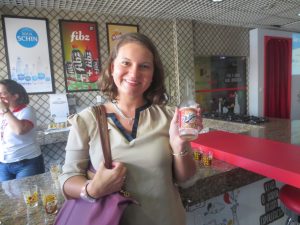Independent Practica
July 5, 2016

Recognizing the increasing importance of international business, I originally selected the Strategy & Marketing for Emerging Countries course in Brazil in order to learn best practices for business development in growing markets like Brazil. And indeed, I received valuable instruction related to bottom-of-the-pyramid consumers, sustainability strategies, and the cultural implications of internationalization. Yet, I think even more valuable lessons came from my classmates, undergraduates to mid-career professionals from Bangladesh to Ecuador and Hungary to Nigeria, and everywhere in between. They brought incredibly diverse perspectives and gave me an idea of how international business relationships might actually be managed.
We were each assigned to a small group to work on an internationalization case study, of either a Brazilian company seeking to develop its business abroad or a foreign company seeking to enter the Brazilian market. In my case, my group included me, a German business student, a Hungarian recent graduate, and a young Angolan professional. We were assigned to work on Havaianas, the well-known Brazilian flip flop company growing its business in the U.S. and Europe. Our differences were evident from our first meeting: some group members had not done the reading or were too timid to contribute, while others had highlighted the entire case and forcefully contributed their opinion. During the course, we had covered how various cultures used direct or contextual communication, and our interactions also reflected these cultural tendencies. I had expected that my German team member and I would be the most similar in how we approached the project, but as it turned out, our differences were the most difficult to navigate. My German group member did away with any formalities and dove directly into the topic at hand, not bothering with delicate delivery. As an American, I, too, was relatively direct but inserted a little more diplomacy, whereas the Hungarian and Angolan group members needed significantly more social conversation before they felt comfortable discussing “business.” Similarly, in conflict, the German student was unyielding in advocating for his opinion and while I was slightly more diplomatic, I was also insistent about my own stance. The other two group members preferred to avoid the confrontation and did not choose sides or push for a compromise. Even the subject of the disagreement reflected two very different notions of business: my German peer wanted to redesign the Havaianas product to match that of Nike, the biggest competitor in the sandals market, whereas I wanted to further differentiate it through stronger cultural branding. The last difference came in the form of our presentation styles: my education had taught me to keep text to a minimum on PowerPoint slides but my German classmate wanted to include full sentences and transitions between every slide. Thankfully, my Angolan team member agreed that we should keep the slides brief and explain orally, but we did have to make some compromises as the German clearly felt out of his element. In the end, our final presentation was a success and we learned applicable lessons for international branding and new product development. Even more important, though, we gained valuable insight into negotiating cultural differences in developing international business relationships in practice.
The experience reminded me of an exercise I had participated in during my MBA orientation at MIIS in August. Toni Thomas had assigned each of us to one of three teams, representing three companies from three different cultures, to conduct a role play of a reception ahead of an important business meeting for a joint venture between the three companies. The cultures varied in their use of direct communication, treatment of authority figures, invocation of religion, physical gestures, and likes and dislikes. In retrospect, this simple exercise prepared me well for my time in Brazil. I was more in tune with cultural cues and better able to adapt myself to the setting and audience. And once we gained an understanding of each other’s differences, my group was well equipped to talk through our ideas, play to each of our strengths, and ultimately deliver a more innovative, compelling final product.



You must be logged in to post a comment.